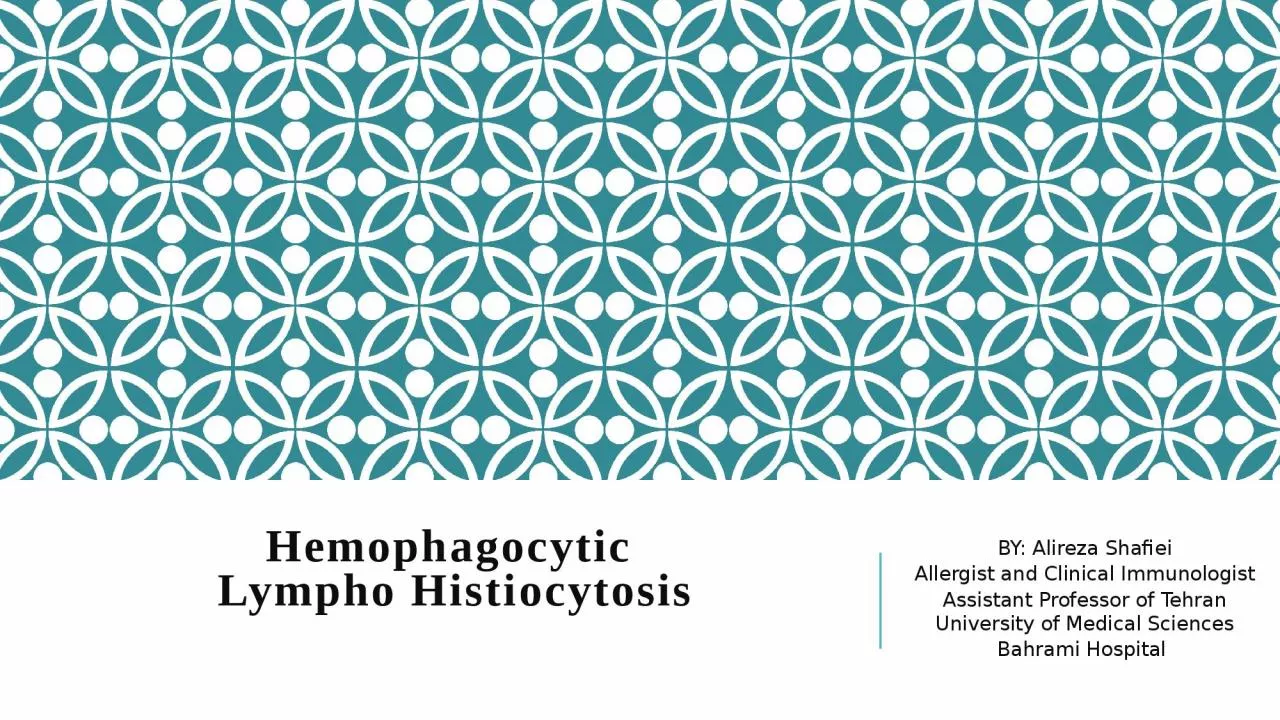

H istiocytosis BY Alireza Shafiei Allergist and Clinical Immunologist Assistant Professor of Tehran University of Medical Sciences Bahrami Hospital Introduction In practice distinction between primary and secondary HLH is not essential for the initial diagnosis and management ID: 927395
Download Presentation The PPT/PDF document "Hemophagocytic L ympho" is the property of its rightful owner. Permission is granted to download and print the materials on this web site for personal, non-commercial use only, and to display it on your personal computer provided you do not modify the materials and that you retain all copyright notices contained in the materials. By downloading content from our website, you accept the terms of this agreement.
Slide1
Hemophagocytic Lympho Histiocytosis
BY:
Alireza
Shafiei
Allergist and Clinical Immunologist
Assistant Professor of Tehran University of Medical Sciences
Bahrami
Hospital
Slide2Introduction:In practice, distinction between primary and secondary HLH is not essential for the initial diagnosis and management.Primary HLH, also called familial hemophagocytic lymphohistiocytosis (FHL), refers to HLH caused by a gene
mutation:
FHL1
, FHL2 , FHL3 , FHL4, FHL5
,
GS2
(
RAB27A
)
,HPS2
,
XLP1
,
XLP2
,
BLOC1S6
,
CD27
,
ITK
,
MAGT1
(
XMEN)
,
SLC7A7
,
XIAP
(BIRC4
)
Secondary (sporadic, acquired) HLH has generally been used to describe those without a known familial mutation; adults; and those for whom a clear trigger of the HLH episode has been identified (
eg
, viral illness, autoimmune disease, lymphoma).
Slide3Slide4Slide5Understanding the pathogenesis of hlhT lymphocytes play an essential role in the induction of the disease manifestations of HLHThe granule-dependent cytotoxic pathway is a rapid, powerful, and iterative mechanism to mediate killing of
virus infected
cells
as well as tumor
cells
Although T cell-mediated
recognition leads
to T cell activation and clonal expansion,
lymphocytes deficient
in cytotoxic function fail to kill
the infected cells.
Elimination of APCs
provides an important negative feedback to
limit T
cell-mediated immune responses.
Slide6Understanding the pathogenesis of hlhIn the absence of effective cytotoxicity, APCs continue to stimulate CTLs,which produce high quantities of cytokines (e.g., INF-γ), thus inducing macrophage activation.
The
sustained
macrophage activation results in tissue
infiltration and
production of high levels of IL-6, IL-18, and
TNF-α, which
cause tissue damage and play a major role in
the clinical
manifestations of the
disease.
Activated macrophages
phagocytose
bystander hematopoietic cells (
hemophagocytosis
).
Activated lymphocytes and
macrophages infiltrate
various organs, resulting in massive tissue necrosis and organ failure
Slide7Immunologic Abnormalities most patients with HLH exhibit impaired cytotoxic function of NK cells and CTLs, coupled with excessive activation of macrophages . Excessive cytokine production by macrophages, NK cells, and CTLs is thought to be a primary mediator of tissue damage The normal elimination of activated macrophages by NK cells and CTLs occurs through the process of
perforin
-dependent cytotoxicity.
NK
cells and CTLs lyse target cells in a series of steps that include formation of an immunologic synapse; creation of a pore in the macrophage membrane; and delivery of
cytolytic
granules into the macrophage.
Slide8Immunologic Abnormalities Hemophagocytosis In addition to antigen presentation and cytokine production, macrophages can also phagocytize host cells. Hemophagocytosis refers to the engulfment (literally "eating") of host blood cells by macrophages. H
emophagocytosis
alone is neither pathognomonic of, nor required for, an HLH diagnosis.
Cytokine
storm
: The persistent activation of macrophages and NK cells and CTLs that occurs in patients with HLH leads to excessive cytokine production (cytokine storm) by all of these cells.
It is thought that the excessive cytokines are ultimately responsible for
multiorgan
failure and the high mortality of the syndrome
Slide9Definition
Slide10Cytokine StormSpectrum of Cytokine-Induced DiseaseNormal response to infxn
SIRS
Severe sepsis
Macrophage activation syndrome
Acquired HLH
Genetic HLH
Systemic Inflammatory Response Syndrome
Slide11Slide12Slide13Slide14Slide15Slide16Slide17Causes of HLHHLHPerforin deficiencyMunc 13-4 deficiency
Syntaxin 11 deficiency
Munc 18-2 deficiency
Unknown gene mutations
Immune deficiencies
Malignancy
Autoimmune diseases
Viral infections
Bacterial infections
Fungal infections
Helminthic
infections
Medications
Slide18Slide19Slide20Immunodeficiency syndromes Griscelli syndrome – Griscelli syndrome (GS) type 2 is caused by mutations in RAB27A, which encodes a GTP binding protein. GS2 is characterized by hypopigmentation, immune deficiency, thrombocytopenia, and/or neurologic defects.
●
Chediak
-Higashi syndrome
–
Chediak
-Higashi syndrome (CHS) is caused by mutations in
CHS1/LYST.
CHS
is characterized by partial
oculocutaneous
albinism, neutrophil defects, neutropenia, and neurologic abnormalities
Slide21Immunodeficiency syndromes X-linked lymphoproliferative disease – X-linked lymphoproliferative disease type 1 (XLP1) is caused by mutations in SH2 domain protein 1A (SH2D1A), which encodes an activator of NK and T
cells.
XLP2
is caused by mutations in X-linked inhibitor of
apoptosis (
BIRC4); the encoded
protein protects cells from apoptosis.
XMEN disease
– X-linked immunodeficiency with magnesium defect, EBV infection, and
neoplasia
(XMEN) disease is another immunodeficiency syndrome with EBV-associated malignancies and rarely HLH
Interleukin-2-inducible T cell kinase (ITK) deficiency
– These patients, like those with XLP and XMEN deficiencies, are unable to control EBV infections. They have a variety of
lymphoproliferative
diseases,
lymphomatoid
granulomatosis
, HLH, and
dysgammaglobulinemia
.
Slide22Immunodeficiency syndromes CD27 (TNFRSF7) deficiency – Missense mutations that reduce expression of CD27 have been associated with a syndrome of severe EBV infections associated with HLH, Hodgkin lymphoma, uveitis, and recurrent infections [49].Hermanski-Pudlak syndrome
–
Hermansky-Pudlak
syndrome (HPS) is a rare disorder characterized by
oculocutaneous
albinism and platelet storage pool deficiency. Several responsible gene mutations have been identified:
HPS1, AP3B1
(
HPS2
),
HPS3
,
HPS4, HPS5, HPS6, DTNBP1
(
HPS7
)
, BLOC1S3
(
HPS8
), and
BLOC1S6
(
PLDN
).
Slide23Slide24Slide25Slide26XLP1 is commonly associated with: Lymphoma hypogammaglobulinemia, aplastic anemia, vasculitis, gastrointestinal inflammation. XLP2 is associated :
atypical/mild HLH-like episodes,
inflammatory bowel disease,
recurrent infections,
hypogammaglobulinemia
,
uveitis,
fistulating
skin disease,
granulomatous hepatitis,
granulomatous,
lymphocytic interstitial lung disease.
CD70 deficiency, CD27 deficiency, ITK deficiency, and MAGT1 all share a strong predisposition to lymphoma.
Slide27Slide28